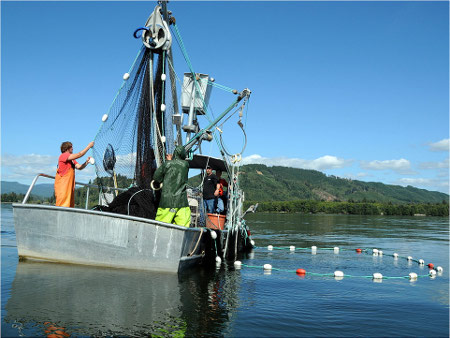forum
library
tutorial
contact

Selective Fishing Methods May Help Future Wild Runs
by Bill RudolphNW Fishletter, April 19, 2011
|
the film forum library tutorial contact |

|
Selective Fishing Methods May Help Future Wild Runs
by Bill RudolphNW Fishletter, April 19, 2011 |
 Commercial fishermen may be netting more hatchery-raised Columbia River salmon in a couple of years, with less impact to ESA-listed stocks than now occurs, if another year of research bears out current trends.
Commercial fishermen may be netting more hatchery-raised Columbia River salmon in a couple of years, with less impact to ESA-listed stocks than now occurs, if another year of research bears out current trends.
By using fishing gear like purse seines that allow wild fish to be released relatively unharmed compared to those captured in gillnets, fishermen may end up with bigger paychecks and help wild stocks by reducing the number of hatchery fish that reach spawning grounds and undermine productivity of wild runs.
That was the take-home message from WDFW's southwest regional manager Guy Norman at last week's meeting of the Northwest Power and Conservation Council. He reported on the 2010 results of selective harvest investigations in the lower Columbia, and said he was "very encouraged" about the future.
Norman said the latest information builds on 2009 results that looked at harvesting fall chinook with beach seines, purse seines and trap nets. He said 2010 allowed 30 days of fishing, from August to late October, a period when beach seines caught 8,000 chinook and coho, purse seines corralled another 14,000 fish, and two trap nets caught only about 50.
He said only 0.1 percent of the fish released from the nets died shortly thereafter.
Unfortunately, the $1.9 million from the Pacific Coast Salmon Recovery Fund and the Mitchell Act appropriation wasn't enough to pay for a long-term mortality study--a project that would involve a tagging and recovery effort way beyond the scope of the current research.
The encouraging results may prove to be a big improvement over survival of chinook and steelhead released from gillnets, where recovery boxes are used to help revive fish before they are returned to the river.
Earlier WDFW research had estimated a whopping 40 percent post-release mortality for wild spring chinook and 30 percent for steelhead when traditional large mesh nets were used. When fishers used much smaller mesh tangle nets, managers expected chinook mortality to be cut by about 50 percent.
Norman said researchers last year had also placed some post-released fish in netpens to see how they fared, but hungry otters ended that part of the experiment.
WDFW plans to continue its research with beach seines and purse seines this coming season, and has committed funding for it, but the all-important long-term mortality study of released fish will only occur if another $850,000 can be found. Norman said some carryover funds may be available, and getting the industry to partner may help, too.
In 2007, the commercial sector didn't express much interest in selective harvest options, but that has changed. He said there were 35 applications filed for 16 slots to test gear this coming season.
Norman acknowledged that more funds are needed for next year--no federal funding is yet lined up, and that could stifle data needs to help with fish allocation issues and a scientifically sound study of release mortality. But if all goes well, the selective harvest option could be in place by 2013, in the management plan for commercial fisheries--with the main focus on the fall season.
Norman said there are obvious periods when the seines would not be very efficient--like during the peak of the summer run, when the seines would easily catch too many sockeye and steelhead.
And it may take awhile before commercial fishermen step up, if they have to spend $10,000 to $30,000 to gear up for the fishery.
Since more people are required to operate the seine gear than the usual one-man gillnetting operation, more fish have to be caught to make it pay. But it's too soon to tell just how the new regime might affect harvest allocations.
And it could help reduce the number of hatchery fish on spawning grounds, Norman said.
Norman's presentation was a thinly-veiled plea for more money from BPA. Though the power-marketing agency has funded some previous research into selective fisheries, notably fish wheels, and currently supports a Colville Tribes project that's investigating the use of beach seines in the Upper Columbia, the agency has been generally more concerned about spring chinook issues than fall chinook.
During the spring, non-Indian commercial and sport fishers are only allowed to keep fish marked by a clipped fin that identifies them as hatchery fish. But during fall fisheries, they are allowed to keep unmarked chinook, since the largest component of the run is usually made of wild fish headed for Hanford Reach.
Seiners might be able to nab a much larger share of coho than they do now, an issue that will no doubt heat up since some upriver tribes have been working to boost coho numbers for their own harvest.
WDFW's Bill Tweit, told NW Fishletter later that the seine options would probably work out the best in the lower Columbia, where many hatchery fall chinook end up on spawning grounds with wild tules. But he said if all hatchery coho were marked, some could be be harvested, and an allowance might be made to catch a portion of the unmarked wild run of upriver rights headed for the Hanford Reach. He said if all upriver hatchery chinook were marked (currently Priest Rapids Hatchery fish are not), then it would be easier for seine operators to sort fish and sell more upriver chinook that command a better wholesale price because they are in better condition than tules after they enter the river.
learn more on topics covered in the film
see the video
read the script
learn the songs
discussion forum
